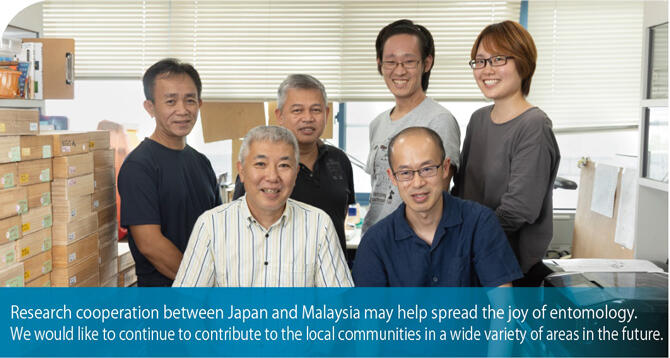The tropical rainforests of Malaysia are hotspots for biodiversity; however, only basic information is available regarding this. In addition to the academic value of this information, it has relevance as an intellectual resource that can be used to foster human resources in science and technology and explore biological resources and is also expected to contribute to the creation of industries. Therefore, investigations into the diverse organisms and their ecosystems in tropical rainforests is highly significant. Professor Takao Itioka and Assistant Professor Hirotoshi Sato of Kyoto University are working with local research organizations to understand the entire biodiversity of the tropical rainforests in the State of Sarawak.
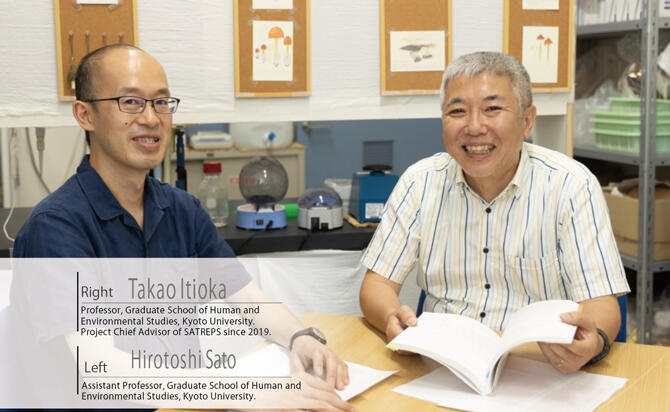
Bringing the benefits of biological resources to local communities and working to create research infrastructure
Insect collecting in the tropics is an enjoyable way to make a wide range of discoveries. Professor Takao Itioka of Kyoto University's Graduate School of Human and Environmental Studies has been fascinated with the biodiversity of tropical rainforests since he was a boy. He grew up and became an entomologist, studying insect ecology and the relationship between environmental conditions and evolution. What do these insects feed on, how do they live, and who are their predators? His research focuses on understanding their relationship with other organisms.
Itioka stresses there are countless research subjects in the rainforests, and that it isn't necessary to head into space or the deep sea to find them. Filled with a boyhood longing, he headed for the tropical rainforests in Sarawak, Malaysia to pursue his interests. The tropical rainforests, which Itioka has been trekking through for more than 30 years, are extremely diverse, species-rich and full of unknown creatures, of which only a few have been named. Many researchers, including Itioka, have made new discoveries in tropical rainforests and published papers on their findings.
Itioka is, however, concerned about the current state of research in this field, which has mainly been led by researchers coming from developed countries. He claims, "In Malaysia, the infrastructure for pursuing independent research is not yet in place, and the techniques and knowledge required for this have not yet been shared. After many years of frequenting Sarawak, I began to think that the method I had employed would not work in the future and that we needed to develop an infrastructure that would benefit the local people as well."
For the people of the country to be able to enjoy the benefits of its biological resources, it was necessary to raise awareness of the value of such resources among the local residents, including researchers. This is because if people recognize that biodiversity has value for multifaceted utilization, it will facilitate the promotion of diversity conservation. In recent years, international momentum has gathered for the protection of tropical rainforests and the equitable utilization of biological resources, and in 2010, the "Nagoya Protocol on Access to Genetic Resources and the Fair and Equitable Sharing of Benefits Arising from their Utilization to the Convention on Biological Diversity" was adopted at the 10th United Nations Biodiversity Conference of the Parties to the UN Convention on Biological Diversity (CBD). The equitable sharing of biological resources is an internationally hot topic.
Against this backdrop, the "Development of Management Systems for Multiple Utilization of Biodiversity in the Tropical Rainforests at the Protected Areas in Sarawak" was launched by JST as a Science and Technology Research Partnership for Sustainable Development (SATREPS) project. Together with Assistant Professor Hirotoshi Sato from the Graduate School of Human and Environmental Studies at Kyoto University and others, in collaboration with two Japanese research institutes, 16 universities and three Malaysian institutions (Forest Department Sarawak, Sarawak Forestry Corporation and Sarawak Biodiversity Center), Itioka is working on an exhaustive survey to clarify the entire biodiversity in the tropical rainforests of Sarawak, and to create Sarawakian research infrastructure for the study of this biodiversity (Figure 1).
Figure 1: Project Management Structure
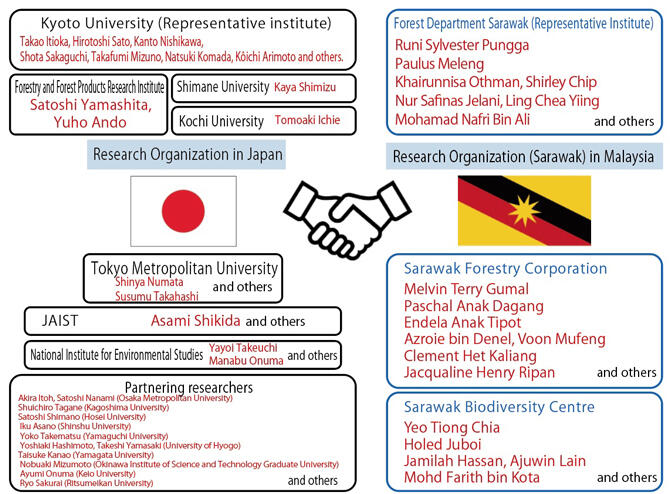
Introducing next-generation DNA sequencing: Large numbers of species can be analyzed at once
The project set up six sub-themes (Figure 2). The core of the project is "Establishment of research systems in the sciences of the biodiversity and promotion of research," i.e., basic research itself. An exhaustive field survey of the biodiversity is conducted in national parks that are protected as biodiversity reserves, and the population of each species is estimated. Although fragmented surveys have been conducted in the past on a single national park and some taxa, never before has a broad area and many taxa been well studied.
Figure 2: Project Structure Chart
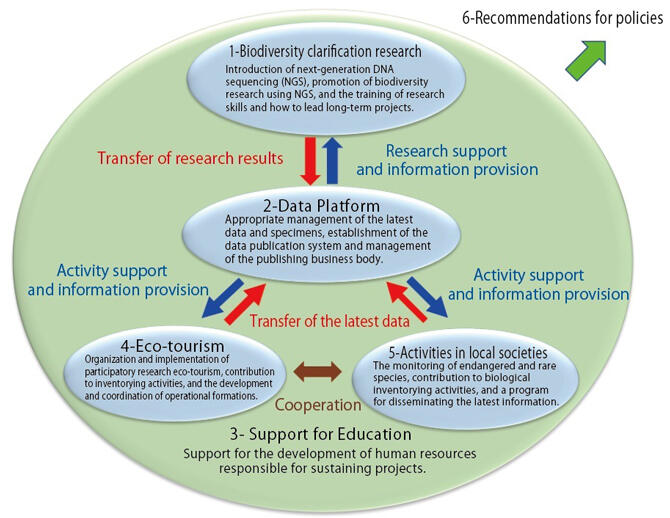
In this study, targets were selected across taxa to collect at more than 15 locations, and their evaluation and analysis were undertaken using Next-Generation Genome Sequencing (NGS). "It used to take five to ten years to identify a collected organism as a new species and name it, but DNA analysis using NGS can easily determine that organisms are different species even if they look similar and that they are the same species or closely related even if they look different. Thanks to technological advances, we can now analyze a large quantity of specimens at one time," explained Itioka, appreciating the significance of the introduction of cutting-edge technologies.
The project installed state-of-the-art equipment in two institutions, the Forest Department Sarawak and Sarawak Biodiversity Centre. A data archiving system that manages DNA information and sample data is being developed to ensure that the outputs of research can be sustainably capitalized on-site in the community. The second sub-theme of the project is 'Establishment of platforms for the multipurpose utilization of information updated by research in the fields of biodiversity sciences.' "As forests disappear and the environment changes, often a creature disappears before it has even been given a name. These basic studies are also crucially important because just knowing which organisms are present in which locations will raise awareness of conservation matters," he added.
While travel was restricted due to Covid-19, spiders that mimic ants were investigated
The project began with high expectations; however, it did not proceed as planned. In 2020, the year after the project began, travel was restricted due to the spread of Covid-19, making field research impossible. To move forward with what was possible, they re-examined the samples gathered during the feasibility study, recorded the collection sites and the number of each taxon, and compiled them into publications.
From this, it became clear that the diversity there was richer than expected. "The number of species is astonishingly large, no matter which taxon you classify them into. I am looking forward to seeing how many unknown species we find once the wide-area survey actually starts," said Itioka while smiling. When such diversity is witnessed, researchers become interested in the way of life of each individual, and immediately start digging into the details.
One of the new discoveries from this study is the Myrmarachne, a genus of ant-mimicking jumping spiders. The spiders mimic ants to better protect themselves from predators, but how does their mobility differ from non-mimics? To examine this, the group analyzed the morphology of 86 individuals of 7 species in Myrmarachne and 70 individuals of 12 genera of non-mimetic jumping spiders collected in Sarawak. To further compare the prey-capture abilities of the two species, a video camera was used to record each individual feeding on a small fly, and the jumping distance and prey-capture success rates were measured.
The results showed that where jumping spiders can leap a distance three times their body length when capturing prey, the maximum jumping distance of the Myrmarachne species is only about the same as their body length, and some species were observed to be unable to jump altogether. The more that the spiders mimicked ants, the less jumping and hunting ability they possessed. Although ant mimicry enabled the spiders to defend themselves against predators, it was evident that this came at a high cost (Figures 3 and 4). Two and a half years after the project began, a field survey finally became possible. Since then, the collection and analysis of the species have been proceeding at a rapid pace. In the coming years, new discoveries will continue to be made not only for unknown species but also for ecology.
Figure 3: Myrmarachne species collected in Borneo and Thailand.
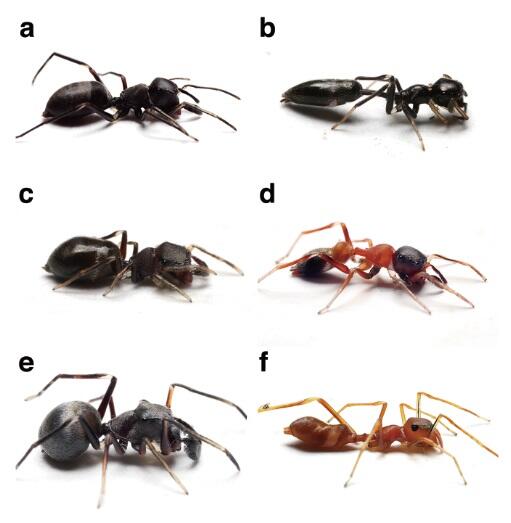
Figure 4: Relationship between the body shape and jumping distance of the Myrmarachne species and non-mimetic jumping spiders.
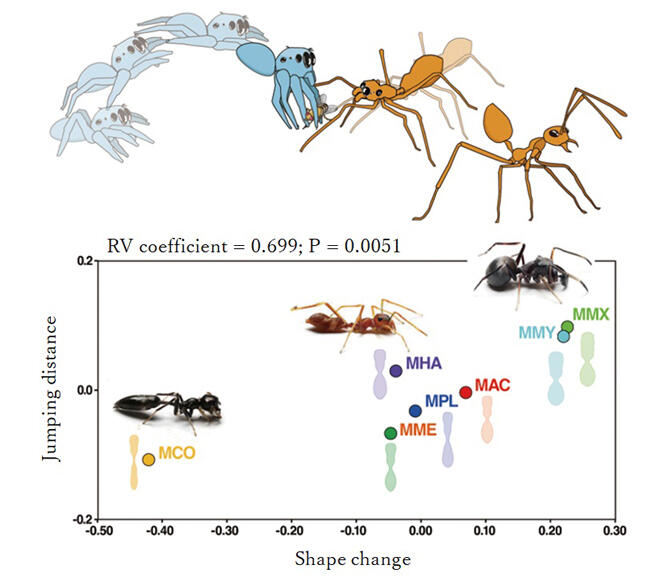
Local researchers studying in Japan are key people in sub-themes
Returning to the sub-themes, the third, "Development of human resources through participation in the project", is a typical element that characterizes the project. Biodiversity research should preferably be led by the local people; however, they lack the knowledge, specimens and skills to work with advanced equipment, making it difficult for them to immediately practice on their own as a researcher. We decided, therefore, to provide them with the knowledge, skills and experiences necessary to become researchers in basic science in the field of biodiversity through joint research.
For this theme, the team was unable to travel due to the COVID-19 pandemic, delaying the transfer of technologies for field surveys and sample processing necessary to conduct DNA analysis using NGS. Sato, who was responsible for technical instruction, states that the remote guidance utilizing manuals had its limitations and that when he found out that the DNA analysis had failed at the local team level, he was frustrated because he could not remotely figure out the cause from Japan. "It started working well when two post-doctoral fellows were finally able to go to the site and directly provide instructions in November 2022 after the travel restrictions were lifted. I realized the importance of teaching face-to-face at a stage where common ground has not yet been reached," he recalls.
The four Sarawak researchers are currently studying in master's and doctoral programs at Kyoto University's Graduate School and Tokyo Metropolitan University's master's program and are working on their theses for their degrees. If a system can be developed that allows them to be trained to a level where they can teach the next generation and foster local researchers, it will be possible to more efficiently research the biology of tropical rainforests in the future. They are the key players that will dictate the success or failure of the third sub-theme.
The collaboration among several institutions in Malaysia is significant in itself. Malaysia is a multi-ethnic country, and its society is more vertically divided than that of Japan. Over the past 30 years, Itioka has often experienced difficulties in the administrative application procedures and coordination among institutions. The same is true for research institutes, which lack horizontal communication, and do not conduct joint research with other institutions. "There are advantages to being in a rivalry, however, there are still things that are better done cooperatively. This time, we wanted to get all three institutions to jointly participate in the project and create a cooperative structure among them."
At the beginning of the collaboration, local researchers rarely communicated with the researchers of other institutions, and even when they did meet, it was hard to get into intimate discussions. However, before long, they began to go back and forth, for example, to borrow experimental equipment from another institution when theirs was out of order. Since they belong to the same laboratory at Kyoto University, they naturally became close friends and shared laboratory equipment. This is another important step toward building Malaysia's future research system.
Eco-tour development and the production of illustrated books: Hopes of encouraging conservation activities
Visitors to the rainforests look forward to encountering rare species. In other words, living creatures constitute a part of the ecosystem services in the tourism industry. Climbing a mountain or walking in a park with a rich ecosystem provides spiritual satisfaction, but currently, we do not know which species is where in the region except for the most well-known creatures such as the proboscis monkeys, orangutans, and Rafflesia, one of the largest flowers in the world. The region is rich in resources, but because there is not a clear idea of the nature of "services" that can be provided, they are not able to effectively highlight the uniqueness of the region, such as "this flower is only found in this national park".
To apply the results of the project to such purposes, the fourth sub-theme, 'Development of eco-tourism utilizing the results of the biodiversity sciences,' and the fifth sub-theme, 'Development of a dissemination program to enhance social recognition of the value of the biodiversity as intellectual property,' were organized. If it becomes clear that certain organisms are only found here, tours can be organized to highlight them, and such information can be used to train guides and improve the signboards in the national parks. Currently, together with the guide associations and tourism offices in the departments of the national parks, the drafting of relevant programs and updating of guide information based on the research products are underway.
A new native region of Rafflesia was discovered last year. The flowers in this region differ slightly in coloration and morphology from previously known Rafflesia and is possibly a new species (Figure 5). Education on nature is rarely offered in schools in Sarawak, but teaching the rarity of Rafflesia and the importance of protecting their habitat through school education and awareness-raising activities among local residents is expected to enhance the local people's attachment to nature, deepen their understanding of the role of rangers as well as nature conservation volunteers' activities and encourage them to engage in conservation activities.
Figure 5: Distinguishing and identifying Rafflesia by DNA analysis
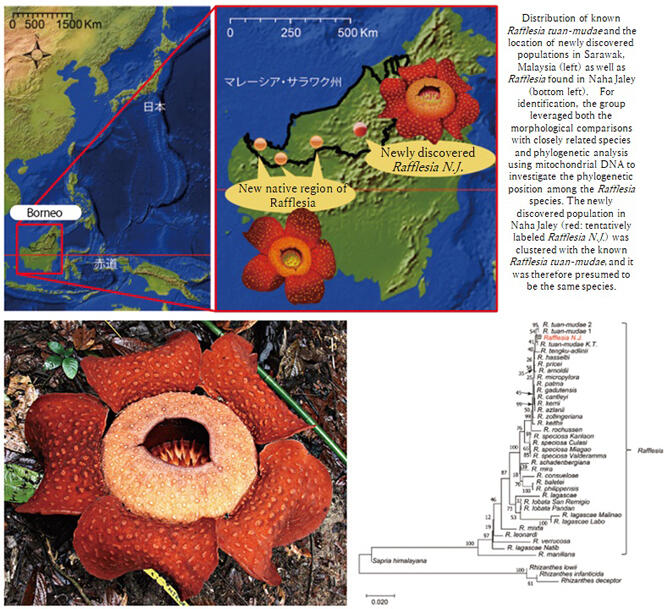
Itioka considers this to be one of the social applications of the results. "The data platform can be successfully used to support the population management and monitoring of valuable species. Moreover, the ripple effects are not small, such as an increase in the number of tourists, the need for guides and an expanded opportunity to sell souvenirs to eco-tourists. It is expected to lead to the creation of new industries, mainly by the local people." Due to the fact that there are too many species of organisms to name, there are no illustrated books in Malaysia. The production of a web-based illustrated book site is under consideration to fill this gap.
Since his first visit to Sarawak in 1994, Itioka has continued his diversity research. Even after the completion of this project, the research will continue to achieve the sixth sub-theme, "Recommendation of policies" (Figure 6). By then, conservation activities and eco-tourism will have been expanded, and the number of nature-watching visitors will probably be greater than now. "The local research system will become more advanced in the future, thanks to the introduction of state-of-the-art equipment and a more focused approach to human resource development. I would like to collaborate with them again to investigate the diversity of tropical rainforests, which is still elusive, and to explore the underlying mechanisms engendering diversity in evolution," Itioka expressed, looking ahead to the future.
Figure 6: Biodiversity survey in a protected area in Sarawak
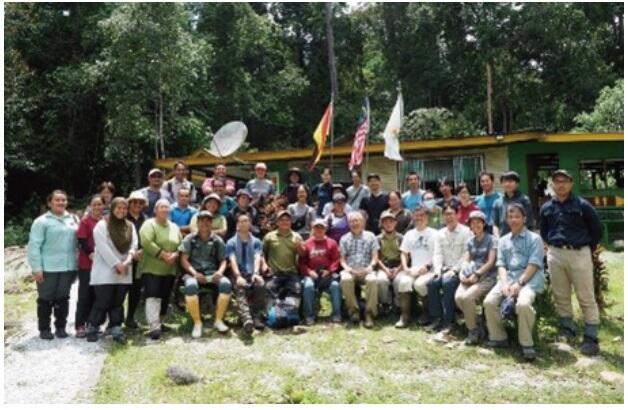
(Article: Yuko Sakurai, Photography: Hideki Ishihara )
